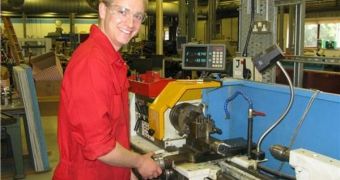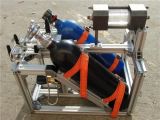James Arkwright, from Morecambe, in Lancashire, the UK, has just secured his place in a prestigious international space competition, as he developed a rocket motor that can be fired safely, and observed from close range. The 25-year-old developed the educational tool as part of his university degree, and is now being asked to present his device in front of world-class scientists, at the International Astronautical Congress, to be held later this month in South Korea, AlphaGalileo reports.
The new motor is only half a meter tall, and is also portable. James developed it after studying aerospace engineering and astronautics for the past five years, at the Kingston University, in South West London. Experts believe that the instrument could be successfully used as an educational tool, to help students, academics and researchers in their quest for obtaining a deeper understanding of the mechanics involved in constructing a rocket.
Made entirely out of the carbon compound graphite, steel and acrylic, the motor can demonstrate to students (from school age to degree level), how fuel is burned inside the combustion chamber. The tool also allows the lookers to observe this phenomenon at close quarters, without the need for computer simulation. The viewers can experience first-hand the path that the fuel takes from the tanks to the exhaust pipe. The motor belongs to the hybrid rocket class, James says.
This new type of vehicles will in the near future be used for space tourism. They will be powered by nitrous oxide and acrylic – a common household plastic that will act as a solid fuel. The burning acrylic increases the pressure inside chamber, generating thrust. James explains, “It’s a bit like when you turn a hosepipe on and the force pushes back on your hand. The heat inside the rocket reaches approximately 3,000 degrees Celsius, so we’ve had to design something which can contain this heat and pass a number of safety tests.”
“Although many private companies carry out similar tests to the ones James has been doing, their results are often commercially sensitive and kept under lock and key. This means researchers can use it to monitor performance and analyze how different types of fuels perform. The motor will allow engineering students and researchers of the future [to] carry out tests which ultimately have the possibility to transform rocket design,” concludes Dr. Barnaby Osborne, who is a senior lecturer in aerospace engineering and astronautics at the university.
“James has done extremely well and follows in the footsteps of Kingston graduates who have gone on to great things in aerospace. Kingston University is continuing to produce high-caliber graduates who can compete on the world stage year after year,” adds Dr. Chris Welch, a principal lecturer in astronautics and space systems.

 14 DAY TRIAL //
14 DAY TRIAL // 
